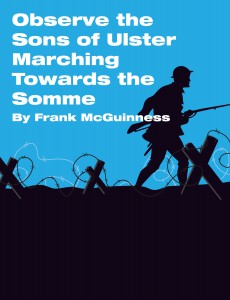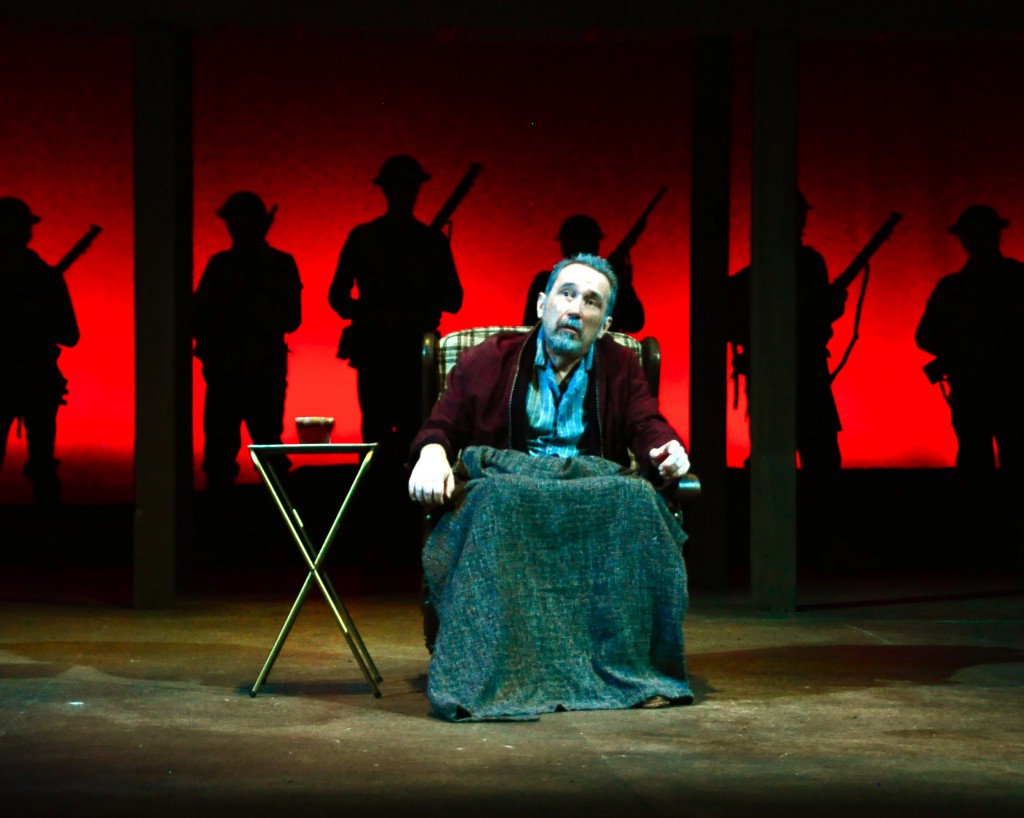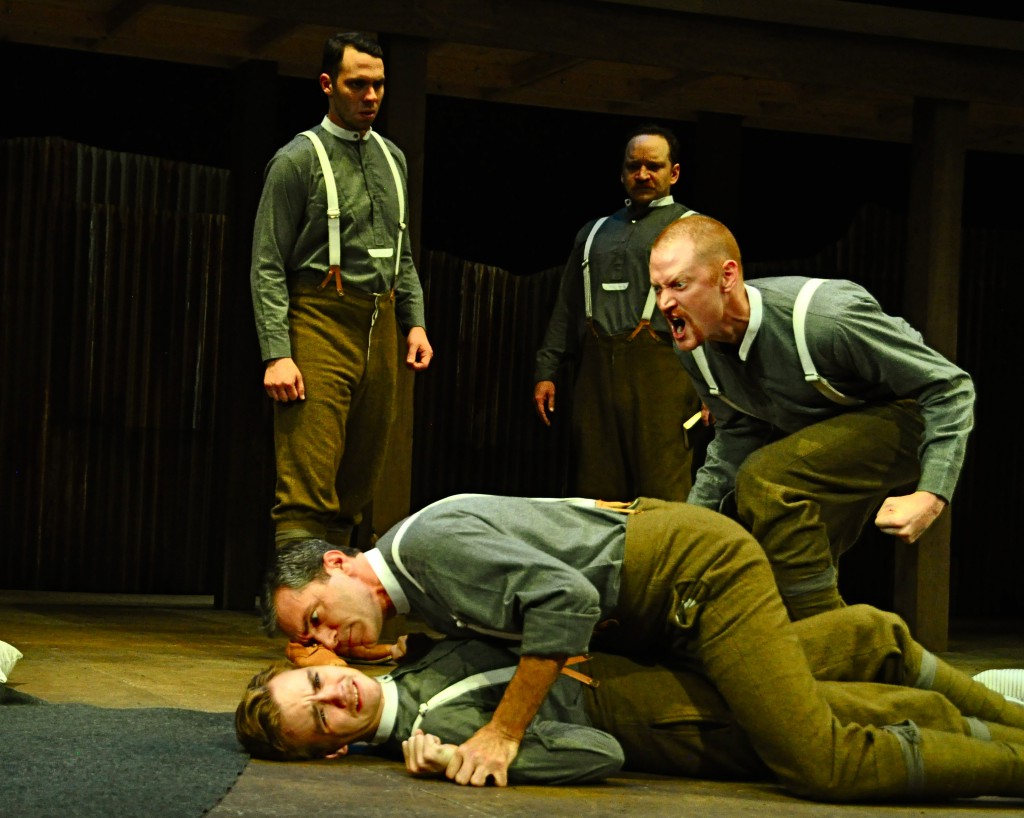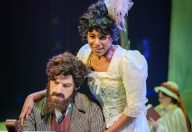“Observe the Sons of Ulster Marching Towards the Somme”

I was very excited when PICT (Pittsburgh Irish & Classical Theatre) released their slate of shows for the 2014 season and I saw Observe the Sons of Ulster Marching Towards the Somme. Although I was not familiar with the play, my interest in it was piqued due to a part of my ancestry being of Irish Catholic descent from the northern Irish county of Antrim. In effect, I am a son of Ulster several times removed (Ulster historically referred to the nine counties of Northern Ireland). Although, my ancestors need not apply to this specific World War I unit, as the members of which had contempt for Irish Catholics, who had been seeking through revolutionary means, beginning in 1916, to achieve a free Irish state and end Britain’s control.
However, many Irish nationalists fought valiantly alongside Protestants for Britain in the war. Sons of Ulster contains occasional commentary about Irish (and other) Catholics. In the play, they’re sometimes called Papists and Fenians, the latter of which comes from an organization of Irish Catholics who sought to form a free Irish republic and was named after ancient Irish warriors.
The military unit in the play was modeled after one in the 36th Ulster Division, who fought proudly and fiercely, partly in order to demonstrate their loyalty to Britain and convince them not to allow for total Irish independence. Although the Irish Republic did win freedom with dominion status from Britain in 1922 (and full independence later), Britain still controls modern-day Ulster, which consists of six counties in the north that have a slight Protestant majority.
War, like politics, makes for strange bedfellows. In Sons of Ulster, the bedfellows, both literally and figuratively, include a soldier who’s secretly Irish Catholic, Irish Protestant soldiers, and two gay soldiers. The soldiers in the play are fighting in World War I (1914 – 1918). Some may remember from high school world history that the war was triggered by the assassination of Austrian Archduke Franz Ferdinand, plus other myriad causes, including a complex of clashing alliances among the world’s most powerful nations. The Triple Entente Alliance contained Britain, France, and Russia (and eventually America). Opposing them were Germany and Austria-Hungary and later the Ottoman Empire.
Sons of Ulster is a detailed historical play and character study written by noted Irish playwright Frank McGuinness . It was originally produced by The Abbey Theatre in Dublin, Ireland in 1985 and even ran at New York’s Lincoln Center Theatre in 2003. In Sons of Ulster, we see a soldier from the unit in his younger and later years—an intense plot device. Old Kenneth Pyper (Martin Giles) opens and closes the play, accompanied by his haunted memories of the toll the meaningless war took on him and his comrades.

Old Kenneth Pyper (Martin Giles), haunted by the ghosts of war.
The staging was simple and highly effective. The outer flanks of the stage each bore a battered, large rectangular piece of corrugated sheet metal, with a large fragmented corner removed. The rectangular piece was vertically aligned. The piece at stage left had the Ulster Banner on it—a white flag with two red stripes that formed a cross, and in the center of it was a star outline with a red hand in the middle and a crown on top of it. At stage right, the sheet metal bore the British Union Jack. Below each piece of metal was a small pile of dirt. To the rear of the stage were basic fortifications. The simple staging was enhanced by effective use of lighting to amplify different moods in the various scenes of the play.
Both before the play started and at the end of intermission, period music played to also set the mood, including the songs “It’s a Long Way to Tipperary” and “Oh, How I Hate to Get Up in the Morning.” The actors were mostly in their uniforms for the entire play, uniforms which appeared to be standard World War I issue right to the top of their heads, with their steel Brodie helmets and standard-issue Lee-Enfield rifles.
Old and Young Kenneth Pyper
Now that we’ve set the stage, let’s get on with Sons of Ulster. The play opens with Old Pyper awaking from a snooze in a well-worn easy chair. He then goes off on a long soliloquy of angry rants against God about losing his fellow soldiers during the war and the meaninglessness of it all. “God, were you not there in all your dark glory?” he loudly asks. About halfway through Pyper’s monologue, the stage rear is bathed in an eerie red light and from the fog emerges his dead soldier friends, slowly advancing as if they were still in battle before stopping motionlessly. Pyper continues his rants and sorrows. He views his younger self (Raife Baker) among the soldiers, and they gaze at each other without speaking.
Next we see the younger Pyper, who’s just reported to the training base in Ireland, sitting and peeling an apple, as other new recruits report. Pyper is a philosophical know-it-all, who enjoys raising the hackles of every one of his new barrack mates, including David Craig (Jason McCune), a steady character; John Millen (Ciaran Byrne) and William Moore (Byron Anthony), who are from the same hometown; former preacher Christopher Roulston (Justin R.G. Holcolmb); youngster Martin Crawford (Dylan Marquis Meyers); and two Orange (Protestant) parade marchers, George Anderson (Jonathan Visser) and Nat McIlwaine (Tony Bingham). The unit starts to build a little cohesion through smoking (what appeared to be actual cigarettes), talking about their hometowns, playing tricks, and beating up a suspected Catholic. Pyper even tells a tale of a three-legged whore he had a relationship with in Paris, a story which captures everyone’s attention. Pyper purposely cuts his hand with a knife and then shakes hands with Craig to become blood brothers. A band of Irish brothers is starting to form.

A suspected Catholic, Martin Crawford (Dylan Marquis Meyers) is assaulted by fellow soldier Nat McIlwaine (Tony Bingham) while fellow agitator George Anderson (Jonathan Visser) spurs the attack. In the background, William Moore (Byron Anthony, left) and Christopher Roulston (Justin R. G. Holcolmb, right) look on.
Clockwork Orange
The next setting for the play occurs back in Northern Ireland, with all soldiers returning from their first battles in France to their hometowns, except for Pyper, who is not close to his family and goes with Craig to his home on Boa Island. In this amazing scene, all actors remain motionless on stage in the setting of their hometown activities, with each pair of actors going into motion on cue to act out their scene. It was like some type of beautiful timepiece as each movement played its role at the exact time. This staging had to have been tough on actors Tony Bingham, who had to hold up a large Orangemen (Protestant) Marching drum, and Justin R. G. Holcolmb, who was kneeling in prayer. The naive bravado of the training camp had given way to nervousness about returning to battle and possibly dying in the war.
Over the Top
The last scenes open in the trenches of France as the men await the call to go over the wall and attack the enemy. They are about to fight in the Battle of the Somme (1916). The battle occurred at various locations around the Somme River in Picardy in northern France. There was nothing tranquil about the fighting around the Somme. It was one of the bloodiest battles of World War I, with Irish regiments bearing the brunt of the casualties.
The soldiers, in this scene, wait nervously behind the lines with ladders leaning on the trench walls. Each helps the others stay calm with pep talks and a little soccer action as they anxiously await their marching orders. The whistles sound, and the commands are shouted that now is their time to join the battle. They bravely join the battle as a very cohesive fighting force with love and respect for one another.

Millen (Ciaran Byrne, l.) and Young Pyper (Raife Baker, r.) get ready for battle.
I attended the first public preview performance, and the actors, under the guidance of director Matt Torney, already seemed like a highly drilled and well-synchronized unit. All actors did a fantastic job of playing their characters, hitting their marks, and projecting their dialogue. The Irish brogues seemed very authentic. Young and Old Kenneth Pyper (Baker and Giles, respectively) both excelled in their lead characters.
The crowd very much enjoyed the play and awarded the actors with a long standing ovation. Martin Giles led the players on a friendly circular march around the stage during the ovation and then stopped at center stage. Even if a play about war is not your cup of tea, this one is especially good due to the fine acting, script, and direction. There is even a little singing in one scene, for those of us who enjoy musicals.
The play is in the Charity Randall Theatre in the Stephen Foster Memorial, at the foot of Pitt’s Cathedral of Learning, 4301 Forbes Ave., Oakland. For show dates, times, and tickets, visit PICT or call 412-561-6000.
Photos by Suellen Fitzsimmons courtesy of PICT Classic Theatre.
Rick Handler is the executive producer of Entertainment Central Pittsburgh and a lover of great entertainment.
Share on Social Media
Follow Entertainment Central
Latest Stories
Sign up for the EC Newsletter







